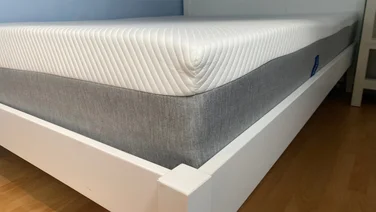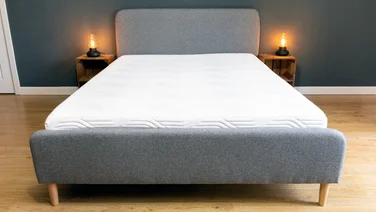To help us provide you with free impartial advice, we may earn a commission if you buy through links on our site. Learn more

If you’ve just invested some serious cash in one of the best mattresses on the market, you’ll want to do everything you can to keep it in tip-top condition. One of the best ways you can ensure a mattress stays supportive, and as even as possible across its surface, is to rotate it every so often (so long as it’s appropriate, but more on that in a moment).
But how do you know if your mattress can be rotated? And, assuming it can be, how do you rotate it safely? Mattresses can be extremely heavy – particularly the larger sizes, such as a king or a super-king – so it’s important to know how to do the job safely, without any risk of injury. We’ll explain more in this guide.
Why do mattresses need to be rotated?
You’ve gone to all the effort of choosing the perfect mattress, so you’ll want to make sure it lasts as long as possible. Beyond protecting your mattress with a high-quality mattress protector and making sure you know how to clean any stains or spills properly, the other thing to do is rotate the mattress regularly. But why?

When we lie on a mattress, our body weight compresses the top layers, allowing us to sink into it. Over time, this wear-and-tear can lead to dips and bumps where your body digs in the most – typically around the pressure points of the head, shoulders, lumbar and hips. Through regular rotation, you’ll spread your use across more of the mattress, helping the structure to remain supportive for longer and keeping the surface even.
READ NEXT: The best mattresses tried and tested by us
Can I rotate my mattress?
Many mattresses can be rotated but there are a few that can’t. Obviously, you should always check the manufacturer’s instructions for your particular mattress model but, as a general rule, mattresses that can’t be rotated are the ones that feature a zoned layer, with support targeted for specific parts of the body. For example, it might be softer around the shoulders and firmer around the hips. If you rotate this sort of mattress you’ll end up with a very uncomfortable night’s sleep, with pressure building where it shouldn’t and a lack of support where you actually need it.
How often should I rotate my mattress?
If your mattress came with instructions, exact timings should be listed on these, or you should be able to find this information on the brand’s website, but most advise rotating the mattress once a month for the first year, and then once every three months after that. This is particularly important for all-foam memory foam mattresses, as foam wears out faster than other materials. We have a full length guide to how often you should rotate your mattress which goes into more detail.
How to rotate a mattress easily
As we’ve already mentioned, mattresses are heavy – even a twin mattress can weigh around 20-30kg – so while it is perfectly possible to rotate a mattress on your own, you have to be careful and, for larger sizes, you will probably need some help. Here are the steps to take for a quick and simple rotation:
Step one: Strip the bed
Before you can rotate your mattress, you’ll need to remove pillows, duvets and any sheets or blankets – we suggest taking the opportunity to wash your bedding so you can put on a fresh set once you’ve finished. If you use an electric blanket, you will need to unplug and remove this too.
Step two: Clear the surrounding areas
If you have lamps or any delicate knick-knacks on your bedside table, make sure to remove these before rotating the mattress. If you don’t, they are likely to end up on the floor, resulting in breakages.
Step three: Rotate the mattress
Rotate a quarter turn, put the mattress down while you move to the foot of the bed and then do another quarter turn. If the mattress has handles, use these to help pull the mattress around. If there are two of you rotating the mattress, stand on either side of the bed and make sure you’ve decided which direction you’re going to turn the mattress before you start.
Step four: Make allowances for your bed base
If your mattress sits on a simple divan without a headboard or footboard, rotating it is going to be a simple job. But if you have a more ornate frame then you’ll need to consider this as you rotate the mattress. If your bed just has a headboard, pull the mattress away from it before you start rotating. If there’s a footboard, you might rest the mattress on it as you rotate.
The bed bases that are the most complicated to rotate mattresses on are undoubtedly four poster beds as these will usually have raised sides, as well as posts in each corner. You will need to rotate the mattress in smaller turns and will definitely need a second person to help lift the mattress around the corner pillars.
READ NEXT: Emma vs Simba: Which is better?
Should I flip my mattress?
Fewer mattresses can be flipped these days, as many are constructed with a base layer that supports the whole mattress. Flip one of these mattresses and you’ll be sleeping on a very hard surface that isn’t comfortable or supportive at all, so it’s vital these stay the right way up.However, there are still some mattresses that can be flipped. For example, traditional innerspring mattresses usually have a fibre filling, springs and padding that’s identical on both sides, so they can be flipped to help keep them stable for longer. You’ll also find some dual firmness mattresses that feature a different firmness on each side, with a support core in the middle, and these can also be flipped.
You don’t need to flip a mattress too often – every six months should be enough for an innerspring mattress.
How to flip a mattress
As with rotating, care must be taken when flipping a mattress as you don’t want to accidentally drop it and risk damaging the bed frame, or yourself. Again, you will probably find this far easier if there are two of you doing the job.
Step one: Strip the bed and clear surfaces
As before, you will have to strip the bed of all bedding, including any electric blankets, and it’s especially advised that you clear away any lamps or breakables from bedside tables.
Step two: Rotate 90-degrees
Start by sliding the mattress out and rotating it 90-degrees so it’s lengthways across the bed. Assuming your mattress isn’t so wide as to be square, this will give you more room to turn the mattress and reduce the risk of it falling off the bed.
Step three: Flip and rotate
Turn the mattress over onto its edge, before lowering it gently back down onto its other side. Don’t let it drop from a height or you could damage the bed frame. Finally, rotate the mattress back into its correct position.






